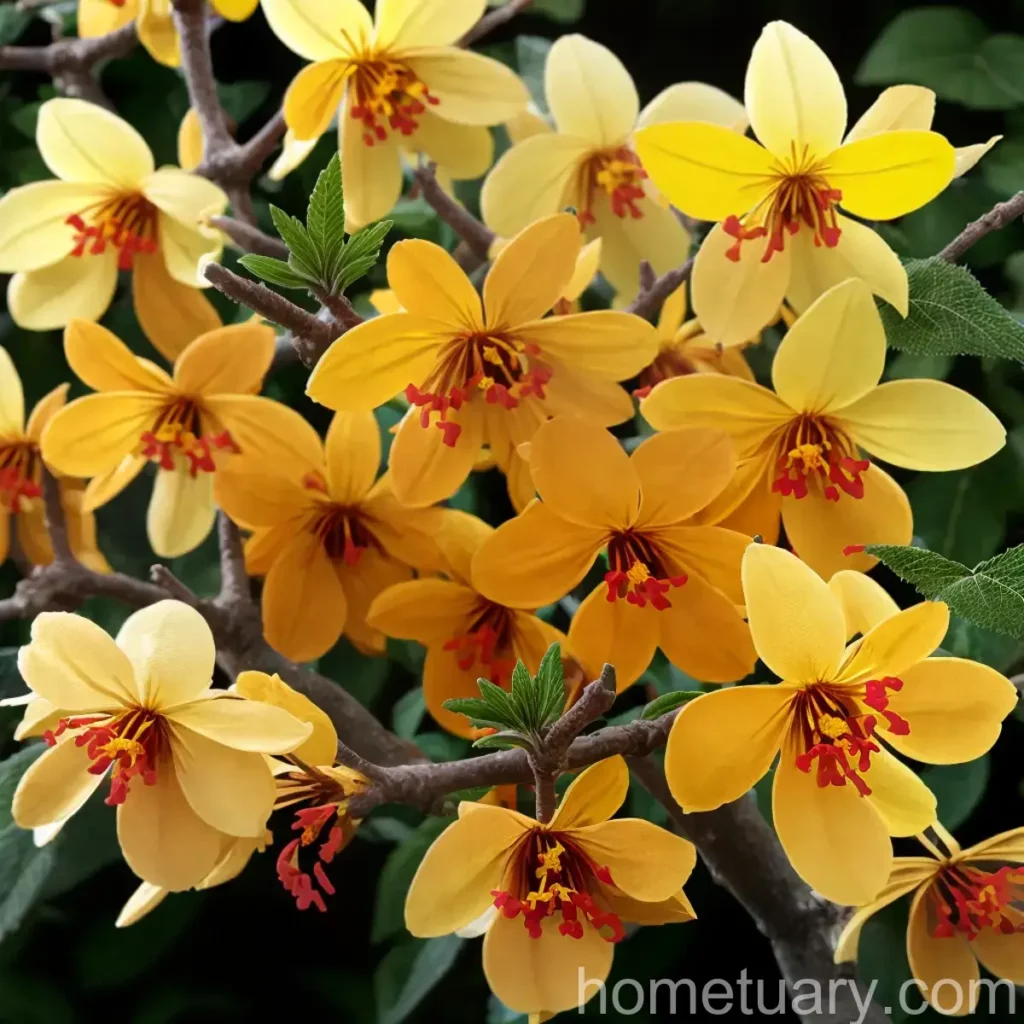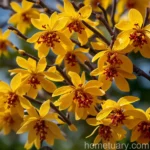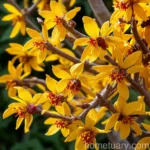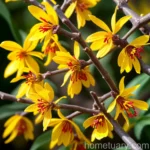Witch Hazel (Hamamelis x intermedia ‘Moonlight’)
Witch hazel is a fascinating and versatile perennial plant that has gained popularity for its unique characteristics and multiple uses. One outstanding variety of witch hazel is the Hamamelis x intermedia ‘Moonlight’. In this comprehensive guide, we will explore everything there is to know about this plant, from its cultural requirements and uses to its propagation, common diseases, and pest control. Join us as we delve into the world of witch hazel and discover the beauty and benefits of ‘Moonlight’ in your garden.
What is Witch Hazel (Hamamelis x intermedia ‘Moonlight’)?
Witch hazel, scientifically known as Hamamelis, is a genus of flowering plants that belong to the family Hamamelidaceae. These deciduous shrubs are native to North America, Japan, and China and are renowned for their captivating flowers, which bloom in late winter to early spring. One of the most enchanting cultivars of witch hazel is the Hamamelis x intermedia ‘Moonlight’, prized for its showy, fragrant flowers and lovely foliage.
Key Takeaways – Witch Hazel (Hamamelis x intermedia ‘Moonlight’)
Before we delve into the specifics of ‘Moonlight’ witch hazel, here are some key takeaways about this delightful plant:
- ‘Moonlight’ is a hybrid witch hazel known for its striking, fragrant yellow flowers.
- It thrives in temperate climates and is prized for its winter and early spring blooms.
- Witch hazel is widely utilized in landscaping, herbal remedies, cosmetics, and fragrance production.
- The plant requires well-draining soil, sufficient sunlight, and moderate watering for optimal growth.
- ‘Moonlight’ can be propagated through softwood cuttings and is generally low-maintenance in terms of pruning and care.
Now that we have an overview of witch hazel and its ‘Moonlight’ variety, let’s explore each aspect in more detail.
Culture
Cultivating ‘Moonlight’ witch hazel involves understanding its specific requirements and growth habits. By providing the right cultural conditions, you can ensure that the plant thrives and offers its exquisite blooms year after year.
Uses
Witch hazel, including the ‘Moonlight’ variety, has a wide range of uses, making it a valuable addition to both home gardens and commercial landscapes. Here are some common uses of this versatile plant:
-
Landscaping: Witch hazel is often used as an ornamental shrub in gardens, parks, and public spaces due to its attractive foliage and vibrant flowers.
-
Herbal Remedies: The bark and leaves of witch hazel have been traditionally used to create herbal remedies for various skin conditions and minor injuries. Witch hazel extract is widely used as a natural astringent and anti-inflammatory agent.
-
Cosmetics: With its soothing and toning properties, witch hazel extract is a popular ingredient in skincare products such as toners, cleansers, and lotions.
-
Fragrance Production: The fragrant flowers of ‘Moonlight’ witch hazel are valued for their sweet, delicate scent, and are sometimes used in perfumery and aromatic creations.
-
Wildlife Attraction: The flowers of witch hazel attract pollinators, including bees, which contribute to the biodiversity of the garden.
Water
Proper watering is essential for the health and vigor of ‘Moonlight’ witch hazel. While the plant is relatively tolerant of dry conditions, it thrives when provided with consistent moisture, especially during periods of active growth and flowering.
-
Young Plants: Newly planted witch hazel should be watered regularly to help establish their root systems. Provide sufficient water to keep the soil evenly moist, but not waterlogged.
-
Mature Plants: Once established, ‘Moonlight’ can withstand short periods of drought. However, during prolonged dry spells, it is advisable to water the plant deeply, ensuring that the root zone receives adequate moisture.
-
Watering Frequency: In general, watering witch hazel every 7-10 days is sufficient, but adjust the frequency based on local weather conditions and soil moisture levels.
-
Mulching: Applying a layer of organic mulch around the base of the plant can help retain soil moisture and regulate temperature, benefiting the overall health of the witch hazel.
Sunlight
The ‘Moonlight’ variety of witch hazel requires adequate sunlight to bloom and thrive. When considering its placement in the garden or landscape, take into account the following sunlight requirements:
-
Full Sun: Ideally, witch hazel should be planted in a location that receives full sun for the majority of the day. This promotes lush foliage and prolific flowering.
-
Partial Shade: While tolerant of partial shade, ‘Moonlight’ may produce fewer flowers and have a more open growth habit when compared to plants grown in full sun.
-
Eastern Exposure: In regions with intense afternoon sun, providing a site with eastern exposure can offer the plant ample morning sunlight while protecting it from the harsh midday and afternoon rays.
Fertilizer
Fertilizing ‘Moonlight’ witch hazel can enhance its growth and flowering performance. However, it’s important to use the right type of fertilizer and apply it at the appropriate times to avoid overstimulating the plant or causing nutrient imbalances.
-
Timing: Apply fertilizer to witch hazel in early spring, just before new growth begins. This provides the plant with the necessary nutrients as it enters its active growth phase.
-
Fertilizer Type: Use a slow-release, balanced fertilizer specifically formulated for acid-loving plants. Alternatively, a fertilizer with a higher concentration of phosphorus can support abundant flowering.
-
Application: Sprinkle the fertilizer around the base of the plant, avoiding direct contact with the stems. Water the area thoroughly after application to ensure that the nutrients are absorbed into the soil.
-
Frequency: For established plants, a single annual application of fertilizer in early spring is usually adequate to meet their nutritional needs.
Soil
The soil requirements of ‘Moonlight’ witch hazel are crucial for its overall health and vitality. By ensuring that the plant is placed in well-draining, suitable soil, you can promote robust growth and flowering.
-
Acidic Soil: Witch hazel thrives in slightly acidic to neutral soil with a pH range of 5.5 to 7.0. Conduct a soil pH test before planting, and amend the soil as needed to achieve the optimal acidity level.
-
Well-Draining Texture: The soil should have good drainage to prevent waterlogging, which can lead to root rot and other issues. Adding organic matter such as compost or peat moss can improve soil structure and drainage.
-
Moisture Retention: While well-draining, the soil should also have good moisture retention capacity to ensure that the plant has access to consistent moisture, especially during dry periods.
-
Soil Amendments: If the native soil is heavy clay or excessively sandy, amending it with organic matter can enhance its fertility and texture, creating a conducive environment for ‘Moonlight’ witch hazel.
Pruning
Pruning plays a vital role in maintaining the health, shape, and flowering potential of ‘Moonlight’ witch hazel. Understanding the pruning techniques and timing for this plant is essential for achieving the desired aesthetic and promoting vigorous growth.
-
Pruning Time: Prune witch hazel immediately after flowering, typically in late spring or early summer. This timing allows for the removal of spent blooms and the reshaping of the plant without impacting the following year’s flower buds.
-
Deadheading: Remove faded flowers by snipping them off at the base of the cluster. This encourages the development of new growth and prevents the formation of seed pods.
-
Thinning: Periodically thin out congested or crossing branches to maintain open, well-ventilated growth and encourage better light penetration throughout the plant.
-
Size Control: While witch hazel has a natural, graceful form, you can trim back overly long or unruly branches to manage the size and maintain a tidy appearance.
-
Sterilization: When making cuts, use clean, sharp pruning shears to avoid causing damage to the plant and minimize the risk of disease transmission.
Propagation
Propagating ‘Moonlight’ witch hazel allows you to increase your plant collection or share this beautiful variety with fellow gardening enthusiasts. The most common method of propagation for witch hazel is through softwood cuttings. Here’s how to propagate ‘Moonlight’ with success:
-
Selecting Cuttings: In early summer, collect 4 to 6-inch cuttings from the terminal ends of healthy, young stems. Choose sections with firm, non-flowering growth and remove the lower leaves to expose the nodes.
-
Preparation: Dip the base of each cutting in a rooting hormone to encourage the formation of roots. Use a well-draining propagation medium such as a mixture of perlite and peat for optimal results.
-
Planting: Insert the prepared cuttings into the propagation medium, ensuring that at least two nodes are buried below the surface. Water the cuttings gently and cover them with a clear plastic bag to create a humid environment.
-
Root Development: Place the cuttings in a warm, bright location, but shield them from direct sunlight. Keep the propagation medium consistently moist to support the development of roots over the next several weeks.
-
Transplanting: Once the cuttings have established a healthy root system, carefully transplant them into individual pots with well-draining soil. Continue to provide them with care and attention as they acclimate to their new environment.
Container Popularity
Witch hazel, including the ‘Moonlight’ variety, has also gained popularity as a container plant. Growing ‘Moonlight’ in a container offers several advantages, including the ability to control its environment and placement, making it an appealing choice for both indoor and outdoor settings.
Container Common Diseases
While container-grown ‘Moonlight’ witch hazel is generally less susceptible to soil-borne diseases and pests, it can still experience certain issues related to its growing conditions. Here are some common diseases that may affect witch hazel in containers:
-
Root Rot: Excessive moisture and poor drainage in containers can lead to root rot, which manifests as wilting, yellowing leaves, and stunted growth. Use well-draining soil and avoid overwatering to prevent this disease.
-
Powdery Mildew: In humid or poorly ventilated environments, ‘Moonlight’ witch hazel may be vulnerable to powdery mildew, characterized by a white, powdery growth on the leaves. Provide ample air circulation to minimize the risk of this fungal disease.
-
Leaf Spot: Leaf spot diseases can occur in damp conditions and may cause dark, irregular spots on the foliage of the plant. Maintain good air circulation and space container-grown witch hazel appropriately to reduce the likelihood of leaf spot.
-
Aphid Infestation: Aphids are a common pest that can affect container plants, including ‘Moonlight’. Regularly inspect the plant for signs of aphids and address any infestations promptly to prevent damage to the foliage.
Disease Diagnosis
Diagnosing diseases in container-grown ‘Moonlight’ witch hazel involves careful observation of the plant’s overall health and symptoms. Here are some key steps to help identify and address potential diseases:
-
Visual Inspection: Regularly examine the leaves, stems, and overall appearance of the plant for any signs of discoloration, wilting, or abnormal growth.
-
Symptom Recognition: Learn to recognize common symptoms of diseases, such as unusual spots, moldy growth, or distorted foliage, which can indicate specific issues affecting the plant.
-
Environmental Assessment: Consider the environmental conditions in which the container plant is situated, including sunlight exposure, humidity levels, and watering practices, as these factors can impact disease development.
-
Consultation: If you suspect that your ‘Moonlight’ witch hazel is afflicted by a disease, seek guidance from local gardening experts, plant pathologists, or extension services to accurately diagnose the issue and determine the most effective course of action.
Botanist’s Tips
As a plant scientist with a passion for witch hazel, I’ve compiled a set of tips to help you successfully grow and enjoy ‘Moonlight’ witch hazel in your garden or landscape. These insights are based on years of research and practical experience with witch hazel cultivation:
-
Site Selection: When choosing a location for ‘Moonlight’, prioritize a spot with well-draining soil and ample sunlight to promote robust growth and prolific flowering.
-
Root Health: Monitor the moisture levels in the root zone, ensuring that the soil is consistently moist but not waterlogged, especially during the plant’s active growth period.
-
Pruning Precision: Practice precise pruning techniques, focusing on deadheading and thinning to maintain the plant’s shape, health, and flowering potential.
-
Fertilization Frequency: Apply a balanced, slow-release fertilizer in early spring to provide essential nutrients for ‘Moonlight’, supporting its overall development and blooming capacity.
-
Container Considerations: If growing ‘Moonlight’ in a container, select a spacious pot with adequate drainage holes and use a high-quality potting mix tailored for acid-loving plants.
-
Disease Vigilance: Routinely inspect the plant for any signs of diseases or pest infestations, and take swift action to address any issues to prevent them from spreading.
-
Seasonal Admiration: Celebrate the unique beauty of ‘Moonlight’ witch hazel by admiring its fragrant, yellow blooms and elegant form during the late winter and early spring seasons.
Fun Facts
To further enhance your appreciation for ‘Moonlight’ witch hazel, here are some fascinating and fun facts about this remarkable plant:
-
Ancient Medicinal Uses: Witch hazel has been used for centuries by Native American tribes for its medicinal properties, and the extract continues to be a popular ingredient in modern herbal remedies and skincare products.
-
Winter Fragrance: ‘Moonlight’ witch hazel blooms in the midst of winter, releasing a delightful, citrusy fragrance that contrasts with the cold, muted landscape, bringing a touch of warmth and vibrancy to the scenery.
-
Sensitive Seed Dispersal: Witch hazel’s seed capsules explosively eject their seeds when mature, propelling them several feet away from the parent plant. This mechanism aids in the dispersal and natural propagation of the species.
-
Astringent Efficacy: The distilled extract of witch hazel bark and leaves possesses astringent properties, making it a valuable addition to first aid kits for treating minor cuts, bruises, and skin irritations.
-
Horticultural Resilience: Witch hazel is known for its resilience and ability to thrive in challenging conditions, making it a desirable plant for gardens and landscapes that experience harsh winters or early spring frosts.
By understanding these fun facts, you can develop a deeper connection to the unique characteristics and historical significance of ‘Moonlight’ witch hazel.
Links to External Resources
For those seeking further information and resources on ‘Moonlight’ witch hazel and the broader topic of Hamamelis cultivation, the following links can serve as valuable references:
- The American Horticultural Society: Witch Hazels in Bloom
- Royal Horticultural Society: Witch Hazels for Year-Round Colour
- University of Florida IFAS Extension: Witch Hazel Production Guide
- Missouri Botanical Garden: Hamamelis x intermedia ‘Moonlight’
These resources offer a wealth of knowledge and insights into the cultivation, uses, and botanical significance of ‘Moonlight’ witch hazel, providing an excellent foundation for further exploration and study.
As we conclude our exploration of the captivating ‘Moonlight’ witch hazel, I hope this comprehensive guide has deepened your understanding of this remarkable plant and inspired you to embrace its beauty and benefits in your own gardening endeavors. Whether you choose to enjoy ‘Moonlight’ as a striking landscape feature, a source of herbal remedies, or simply a delightful addition to your outdoor space, may the charm and resilience of this witch hazel variety enrich your botanical pursuits for years to come.
With the completion of this comprehensive guide, we’ve covered all aspects of ‘Moonlight’ witch hazel, from its cultural requirements and uses to disease management and fun facts. Whether you’re a seasoned gardener or new to the world of witch hazel, I hope this resource provides valuable insights and inspiration for cultivating and appreciating the beauty of ‘Moonlight’ in your garden or landscape.















